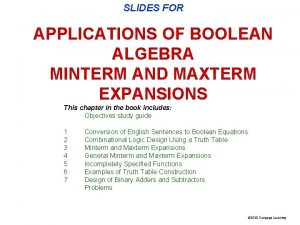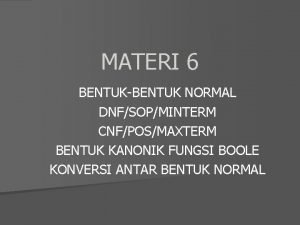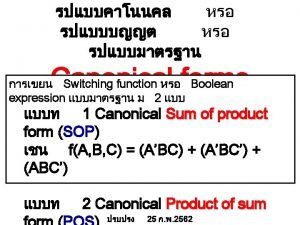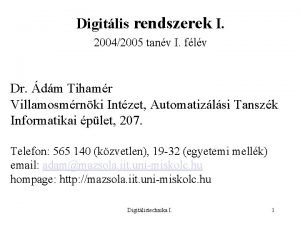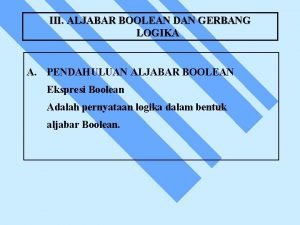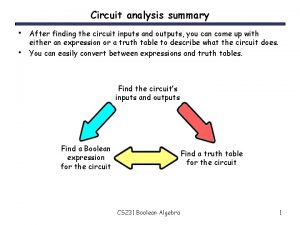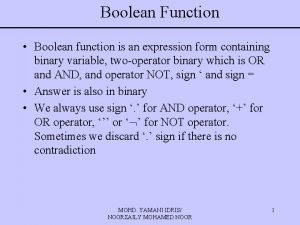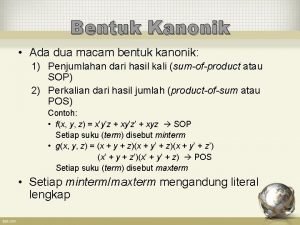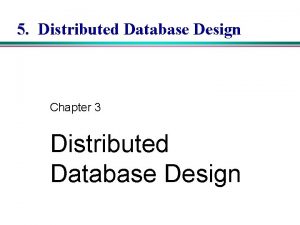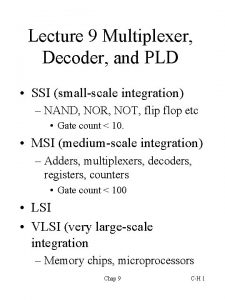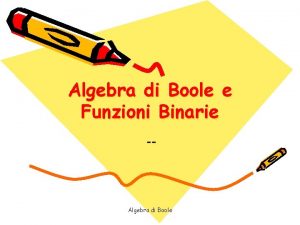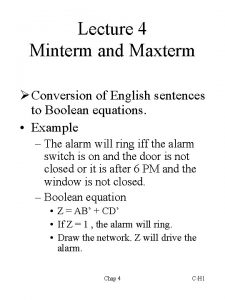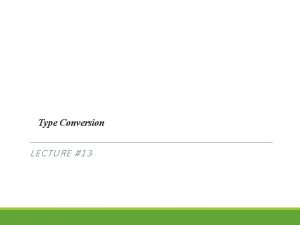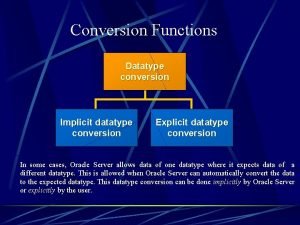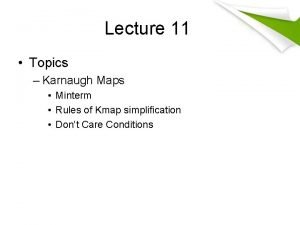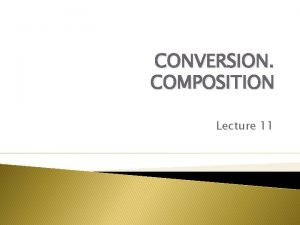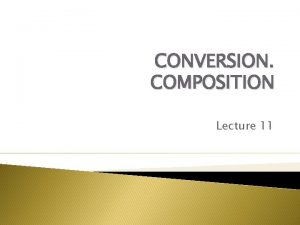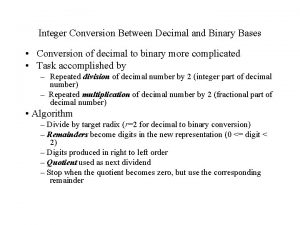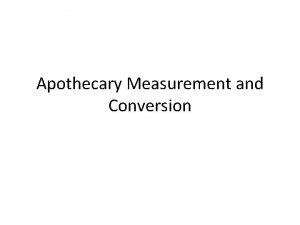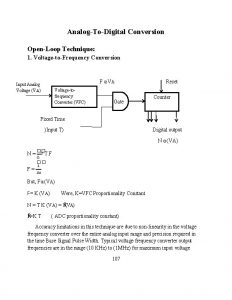Lecture 4 Minterm and Maxterm Conversion of English
























- Slides: 24

Lecture 4 Minterm and Maxterm Ø Conversion of English sentences to Boolean equations. • Example – The alarm will ring iff the alarm switch is on and the door is not closed or it is after 6 PM and the window is not closed. – Boolean equation • Z = AB’ + CD’ • If Z = 1 , the alarm will ring. • Draw the network. Z will drive the alarm. Chap 4 C-H 1

Combinational Network Specified in a Truth Table • Problem statement v. Input 3 bits A, B, C = Binary number N. Output f = 1 if N >= 011 and f = 0 if N < 011. A B C f 000 001 010 011 100 101 110 111 0 0 0 1 1 1 Chap 4 C-H 2

Derive Algebraic Expression from Truth Table • Using f = 1 gives the SOP form. f = A’BC +AB’C’ + AB’C + ABC’ + ABC = A’BC + AB’ +AB = A’BC + A = A + BC. • Using f = 0 gives the POS form. Maxterms are multiplied together so that if any one of them is 0, f will be 0. See what happens if using OR. f = (A+B+C)(A+B+C’)(A+B’+C) = (A+B)(A+B’+C) = A+BC Chap 4 C-H 3

Minterm and Maxterm Ø Minterm – A minterm of n variables = product of n literals in which each variable appears exactly once either in T or F form, but not in both. (Also known as a standard product term) – Each minterm has value 1 for exactly one combination of values of variables. E. g. ABC, 111 => m 7 – A function can be written as a sum of minterms, which is referred to as a minterm expansion or a standard sum of products. Chap 4 C-H 4

Minterm/Maxterm Ø Three variables Chap 4 C-H 5

Minterm Notation Ø f = A’BC + AB’C’ + AB’C + ABC’ +ABC; The other way to represent f is: f (A, B, C) = m 3 + m 4 + m 5 + m 6 + m 7 or f (A, B, C) = m(3, 4, 5, 6, 7) Another view, f (A, B, C) =0. m 0+ 0. m 1 +0. m 2+ 1. m 3 +1. m 4 +1. m 5 +1. m 6 +1. m 7 ü Minterms present in f correspond with the 1’s of f in the truth table. Chap 4 C-H 6

Maxterm • Maxterm – A maxterm of n variables = sum of n literals in which each variable appears exactly once in T or F from, but not in both. – Each maxterm has a value of 0 for exactly one combination of values of variables. E. g. A + B + C’, 001 => M 1 (the value is 0). – Therefore Mi = m’i. – A function can be written as a product of maxterms, which is referred to as a maxterm expansion or a standard product of sums. Chap 4 C-H 7

Maxterm Notation f = (A+B+C)(A+B+C’)(A+B’+C) f (A, B, C) = M 0 M 1 M 2 or f (A, B, C) = M (0, 1, 2) ü Maxterms present in f correspond with the 0’s of f in the truth table. Chap 4 C-H 8

M and m Relationship • If the minterm expansion for f (A, B, C) = m 3 + m 4 + m 5 + m 6 + m 7 , what is the maxterm expansion for f(A, B, C)? üChoose those not present in the minterms. – So the Maxterm expansion for f(A, B, C) = M 0 M 1 M 2. Chap 4 C-H 9

Complement of minterm • Complement of a minterm is the corresponding maxterm. • Example if f = f (A, B, C) = m 3 + m 4 + m 5 + m 6 + m 7 ü f’ = (m 3 + m 4 + m 5 + m 6 + m 7)’ = m’ 3 m’ 4 m’ 5 m’ 6 m’ 7 = M 3 M 4 M 5 M 6 M 7 Chap 4 C-H 10

Find the Minterm Expansion ü f(a, b, c, d) = a’(b’+d) + acd’. = a’b’ +a’d + acd’ = a’b’(c+c’)(d+d’) + a’d(b+b’)(c+c’) + acd’(b+b’) = a’b’c’d’ + a’b’c’d + a’b’cd’ +a’b’cd + a’bc’d + a’bcd + abcd’ +ab’cd’ = Σm(0, 1, 2, 3, 5, 7, 10, 14) What is the maxterm expansion for f? Chap 4 C-H 11

Find the Maxterm Expansion f(a, b, c, d) = a’(b’+d) + acd’. = (a’+cd’)(a +b’+d); Use (x+y)(x’+z)=xz +x’y. = (a’+c)(a’+d’)(a+b’+d); Use (x+y)(x+z) = x+yz. = (a’+bb’+c+dd’)(a’+bb’+cc’+d’)(a+b’+cc’+d) = (a’+bb’+c+d)(a’+bb’+c+d’)(a’+b b’+c’+d’)(a+b’+cc’+d) = (a’+b+c+d)(a’+b’+c+d)(a’+b+c+d’)(a’+b’+c+d’ )(a’+b+c’+d’)(a’+b’+c’+d’)(a+b’+c+d)(a+b’+c’ +d) =ΠM(4, 6, 8, 9, 11, 12, 13, 15); primed = 1, unprimed = 0. Note that maxterm = 0. Chap 4 C-H 12

General Expressions • n variables (i = 0 to 2 n-1 values) Minterm : F =Σaimi If ai = 1, then minterm mi exists. Maxterm : F =Π(ai+Mi); If ai = 1, then the maxterm does not exist. ü Note that Σaimi = Π(ai+Mi) ü F’ = [Π(ai+Mi)]’= Σai’Mi’ = Σai’mi = Π(ai’+Mi) Chap 4 C-H 13

Incompletely Specified Functions • Don’t care terms. – A’B’C and ABC’ are “don’t care” term. We don’t care the value of these terms, whether it is 1 or 0. ü Example F= A’B’C’+A’BC +ABC = A’B’C’ + BC (assign 0 to both X’s) F = A’B’C’+A’B’C+A’BC+ABC = A’B’+BC (assign 1 to first X and 0 to the second) F = A’B’+BC+AB (assign 1 to both X’s). Chap 4 C-H 14

Minterm Expansion for Don’t Care • Example – Minterm • F = Σm(0, 3, 7) + Σd(1, 6) – Maxterm • F = ΠM(2, 4, 5). ΠD(1, 6) Chap 4 C-H 15

Don’t Care What if A B C f x x 0 1 f = c’ f = 000 010 100 110 Chap 4 C-H 16

Examples • 1’s complement adder Chap 4 C-H 17

Full Adder • One bit Chap 4 C-H 18

2’s Complement Adder • Form 2’s complement for minus operand for subtraction Chap 4 C-H 19

Full Adder Using Gates module fulladd (Cin, x, y, s, Cout); input Cin, x, y; output s, Cout; xor (s, x, y, Cin); and (a, x, y); and (b, x, Cin); and (c, y, Cin); or (Cout, a, b, c); endmodule fulladd (Cin, x, y, s, Cout); input Cin, x, y; output s, Cout; xor (s, x, y, Cin); and (a, x, y), (b, x, Cin), //omit and (c, y, Cin); or (Cout, a, b, c); endmodule 20

Full Adder Using Functional Expression module fulladd (Cin, x, y, s, Cout); input Cin, x, y; output s, Cout; assign s = x ^ y ^ Cin, Cout = (x & y) | (x & Cin) | (y & Cin); endmodule 21

3 -bit Ripple Adders module adder 3 (c 0, x 2, x 1, x 0, y 2, y 1, y 0, s 2, s 1, s 0, carryout); input c 0, x 2, x 1, x 0, y 2, y 1, y 0; output s 2, s 1, s 0, carryout; fulladd b 0 (c 0, x 0, y 0, s 0, c 1); fulladd b 1 (c 1, x 1, y 1, s 1, c 2); fulladd b 2 (c 2, x 2, y 2, s 2, carryout); Instantiate the fulladd module endmodule fulladd (Cin, x, y, s, Cout); input Cin, x, y; output s, Cout; assign s = x ^ y ^ Cin, assign Cout = (x & y) | (x & Cin) | (y & Cin); endmodule 22

3 -bit Ripple Adders Using Vectored Signals module adder 3 (c 0, x 2, x 1, x 0, y 2, y 1, y 0, s 2, s 1, s 0, carryout); input c 0, x 2, x 1, x 0, y 2, y 1, y 0; output s 2, s 1, s 0, carryout; fulladd b 0 (c 0, x 0, y 0, s 0, c 1); fulladd b 1 (c 1, x 1, y 1, s 1, c 2); fulladd b 2 (c 2, x 2, y 2, s 2, carryout); Vectored signals used module adder 3 (c 0, X, Y, S, carryout); input c 0; input [2: 0] X, Y; output [2: 0] S; output carryout; wire [2: 1] C; fulladd b 0 (c 0, X[0], Y[0], S[0], C[1]); fulladd b 1 (C[1], X[1], Y[1], S[1], C[2]); fulladd b 2 (C[2], X[2], Y[2], S[2], carryout); endmodule fulladd (Cin, x, y, s, Cout); input Cin, x, y; output s, Cout; assign s = x ^ y ^ Cin, assign Cout = (x & y) | (x & Cin) | (y & Cin); endmodule 23

Overflow and Carry-Out detection For unsigned number carry out from n-1 bit position: If both xn-1 and yn-1 are 1 or If either xn-1 or yn-1 is 1 and sn-1 is 0. Hence, carryout = xn-1 yn-1 + ~sn-1 xn-1 + ~sn-1 yn-1 n-bit signed number: -2 n-1 to 2 n-1 -1 Detect overflow for signed number: Overflow = Cn-1 ⊕ Cn Overflow = Xn-1 Yn-1 ~Sn-1 (110) + ~Xn-1 ~Yn-1 Sn-1 (001) (summation of two same signs produce different sign) where X and Y represent the 2’s complement 0111 numbers, S = X+Y. (sign bits 0, 0 ≠ 1 ) 0111 1111 24
 Minterm and maxterm
Minterm and maxterm Minterm
Minterm Pos maxterm
Pos maxterm Minterm notation
Minterm notation Karnaugh tábla
Karnaugh tábla Diszjunktív konjunktív átalakítás
Diszjunktív konjunktív átalakítás 01:640:244 lecture notes - lecture 15: plat, idah, farad
01:640:244 lecture notes - lecture 15: plat, idah, farad Maksterm
Maksterm Minterm
Minterm Rumus boolean
Rumus boolean Sum of minterm
Sum of minterm Sum of minterm form
Sum of minterm form Canonical form boolean algebra
Canonical form boolean algebra Apa itu sop dan pos
Apa itu sop dan pos Minterm predicate
Minterm predicate Dewan tanvir ahmed
Dewan tanvir ahmed Kanonik minterm
Kanonik minterm Ssi
Ssi Kanonik adalah
Kanonik adalah Funzioni binarie
Funzioni binarie English literature lecture
English literature lecture English language lecture
English language lecture English and metric system
English and metric system English unit conversion
English unit conversion Counting significant digits
Counting significant digits

